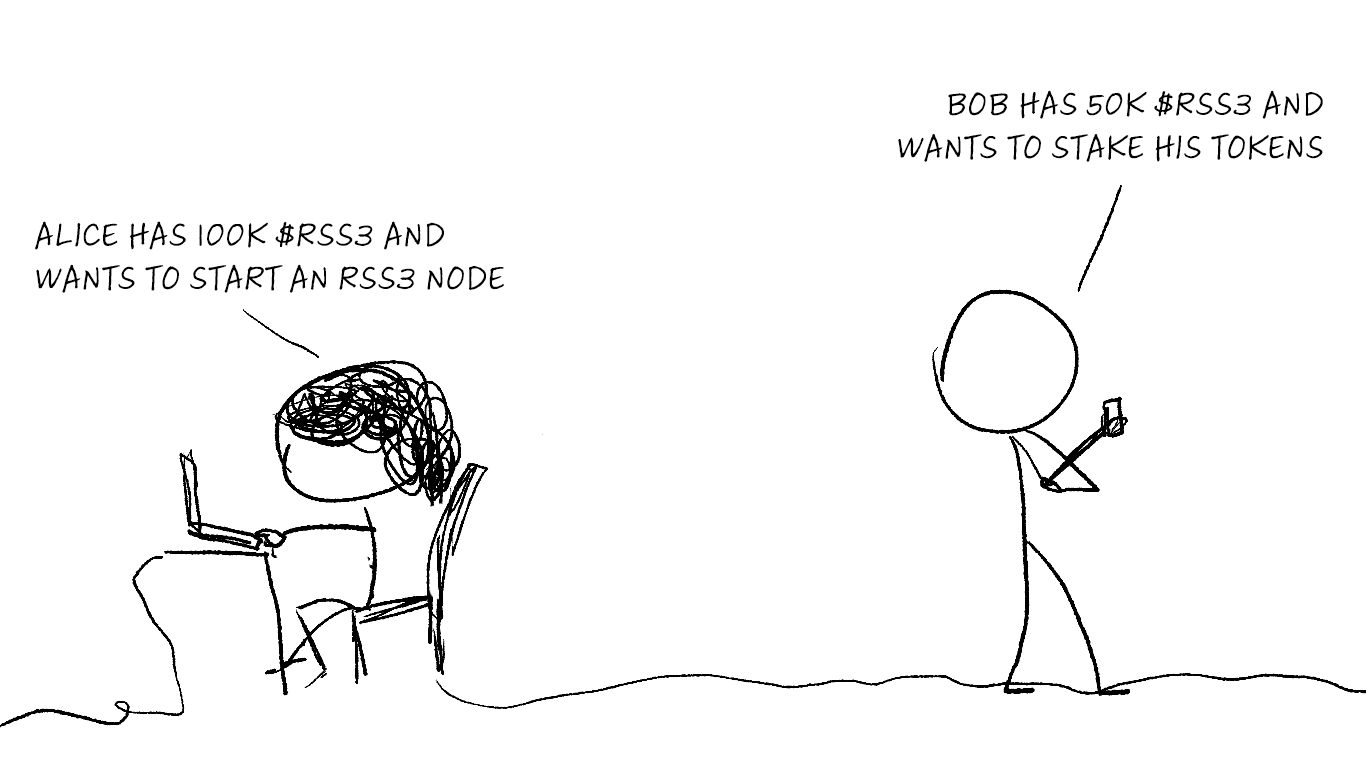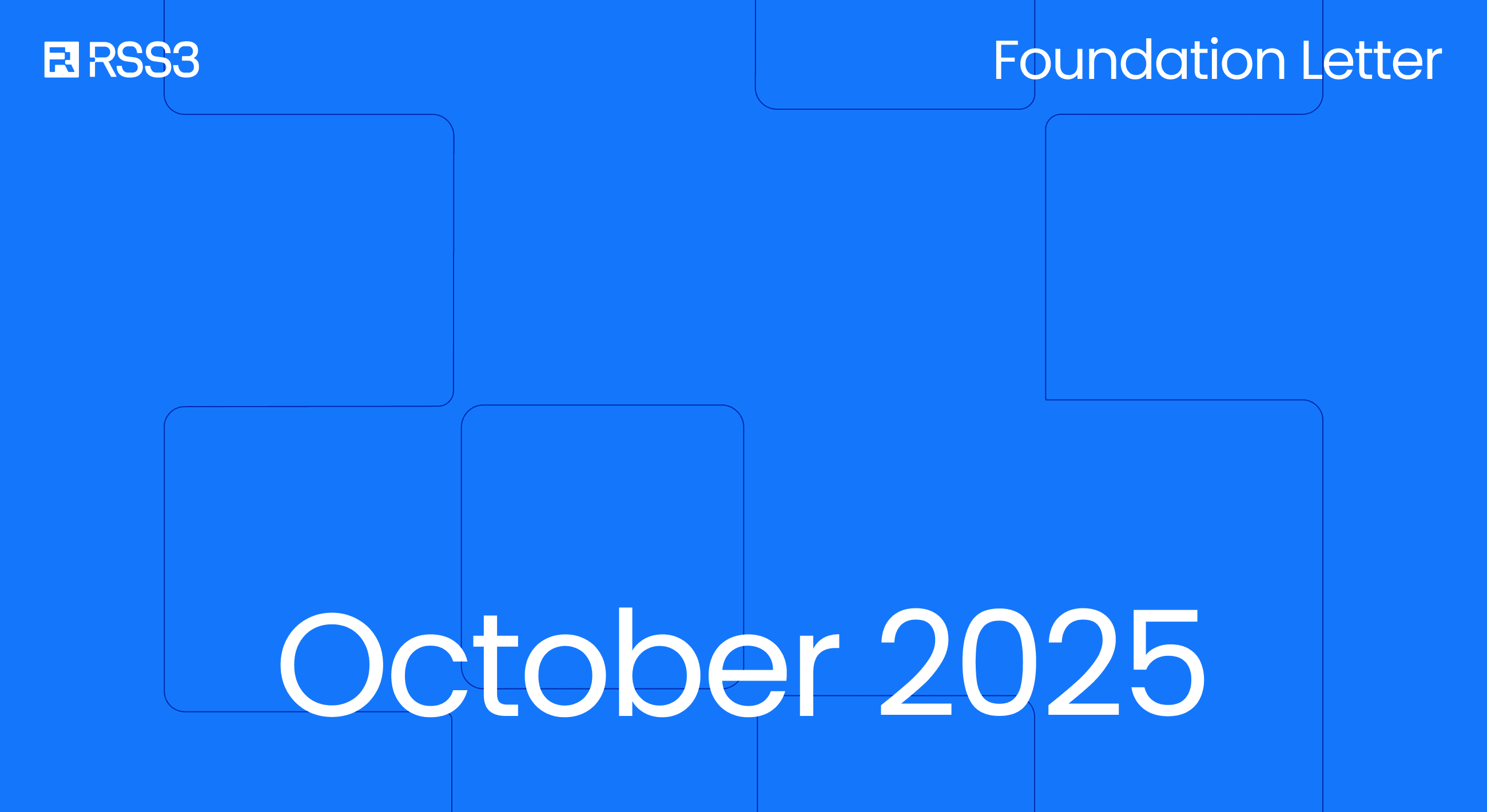Hi guys! As RSS3 is launching its Alpha Mainnet, I’m really excited to share a simple strategy here to help you better navigate the Mainnet Tokenomics. Before reading the following strategy, I recommend you take a look at the complete tokenomics design - I know it’s long, but it’s always nice to know the big picture before jumping into executions.
The RSS3 Network distributes rewards as shown in the diagram.

Note that for Alpha Mainnet, only the components marked with red squares are available—other components will be released with Beta and Production Mainnet.
Now, without further ado, let’s jump right into it with the story of Alice and Bob:
Alice has 100k $RSS3 and is confident in attracting delegators…
The best strategy for Alice is to use the 10k $RSS3 to start an RSS3 Node. Starting a node is simple and easy with the tutorial here (especially during the Alpha Mainnet period, where nodes are really easy to set up). If Alice wants to run a node through a delegated provider, she can try Symphonia, a third-party node provider. According to the tokenomics doc, to start a node, she needs 10k $RSS3 as the deposit.
- The Node Operator receives the taxed amount in full if its deposit meets the following conditions:
When she sets up her node, a tax rate will be set—the tax rate can be changed anytime AFTER the production Mainnet, but for Alpha and Beta, she must ensure that the tax is correctly configured.
Now that she has set up her node and has started attracting external delegators–let’s take a look at the first formula above. When she taxes delegated tokens, the maximum taxable amount is 25 times her deposit. So, with the 10k initial deposit, she can now tax as many as 250k tokens delegated to her node.
Let’s stop here and do a simple calculation on her potential return:
-
denotes the Staking Rewards for a given Normal Node , at the end of a given epoch , where is allocated to the Normal Node’s in proportion to the amount of staked tokens in the entire Network during the last .
The network rewards for Alpha Mainnet are only related to staking. According to the tokenomics doc, staking rewards are distributed proportionally to staked tokens on different nodes.
Assume that 100 million RSS3 tokens are staked into the whole network; that gives an average APY of 30/100 = 30% (Of course, this marks a situation in the beginning - APY will be different according to the amount of staked tokens for the whole network).
Referring to the tokenomics doc, with a tax rate of 10%, Alice’s APY from the deposited 10k $RSS3 will be:
Alice's APY
= Total Staked Tokens in Alice’s Node * Average Network Staking APY * Tax Rate / Deposited Tokens
= 250,000 * 30% * 10% / 10,000
= 75%
Afterward, she can add more tokens to the deposit to match the 25X ratio as the number of external staked tokens grows.
For all the remaining tokens that Alice owns, she can choose to delegate to different nodes.
Alice can also set up a Telegram group for her delegators. They can discuss the node's configurations, especially with Beta and Production Mainnet.
Bob has 50k $RSS3 and does not expect to attract other delegators…
Bob's best strategy is to stake his tokens in one or several RSS3 Nodes. Delegating to a node is very simple through the RSS3 Explorer.

You can find all available nodes in the explorer with all their stats:
- Mode: For Alpha Mainnet, there will only be Alpha Nodes.
- Staking Pool: The amount of tokens staked in the pool
- Operation Pool: The amount of tokens deposited by the node operator
- Tax Rate: The tax rate for the node
- # of Chips: The number of Chips minted from the node with tokens delegated
- Chip Redeem Price: The amount of $RSS3 one will get by redeeming a Chip
In most cases, Bob will consider some of the following factors when choosing a node to delegate:
- Is this node operated by someone I know or trust?
- Is this node trusted by other delegators?
- Is this node practicing a reasonable tax rate?
- Will this node process more requests than others? (N/A for Alpha Mainnet)
Bob ends up choosing two nodes to delegate. He stakes his 22k tokens in a node called “The Happy Lucky Node” with a tax rate of 10% and a Chip Price of 11k. Then, he will be granted 2 Chips for the node as proof of his delegation. Then he stakes another 28k tokens in a node called “Make RSS Great Again” with a tax rate of 8% and a Chip Price of 7k. He then gets 4 Chips.
-
When one stakes $RSS3 to Normal Node , that party will be minting corresponding NFT(s), the RSS3- Chip (), which represents the underlying staked $RSS3:
Now, if we still assume that the total number of delegated tokens is 100m with an annual network APY of 30%, then Bob will have an APY of:
Bob’s APY
= (The tokens Bob stakes on Node A * Network APY * (1 - Tax Rate of Node A) + The tokens Bob stakes on Node B * Network APY * (1 - Tax Rate of Node B)) / Bob’s total staked tokens
=(22,000 * 30% * (1-10%) + 28,000 * 30% * (1-8%)) / 50000
= 27.336%
Note that during Alpha and Beta Mainnet, delegators will not be able to redeem Chips for tokens–that will be available with Production Mainnet. Neither can any node operator change the tax rate until that.
However, Bob can choose to trade his Chips—either by bridging to Ethereum Mainnet and listing on OpenSea or Blur or by seeing if there is an NFT exchange built upon RSS3 VSL.
Conclusion
The above covered two examples of what can be done with your $RSS3 on its mainnet. When bridged to the RSS3 VSL, $RSS3 will be both the gas and vehicle to participate in tokenomics. Of course, as VSL is indeed a permissionless environment for deploying AI and information-related smart contracts, we assume there will be an increasingly thriving ecosystem where a lot more can be done—stay tuned!



